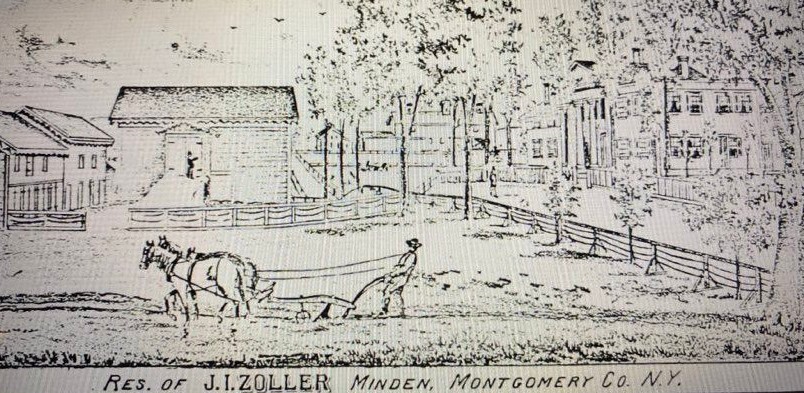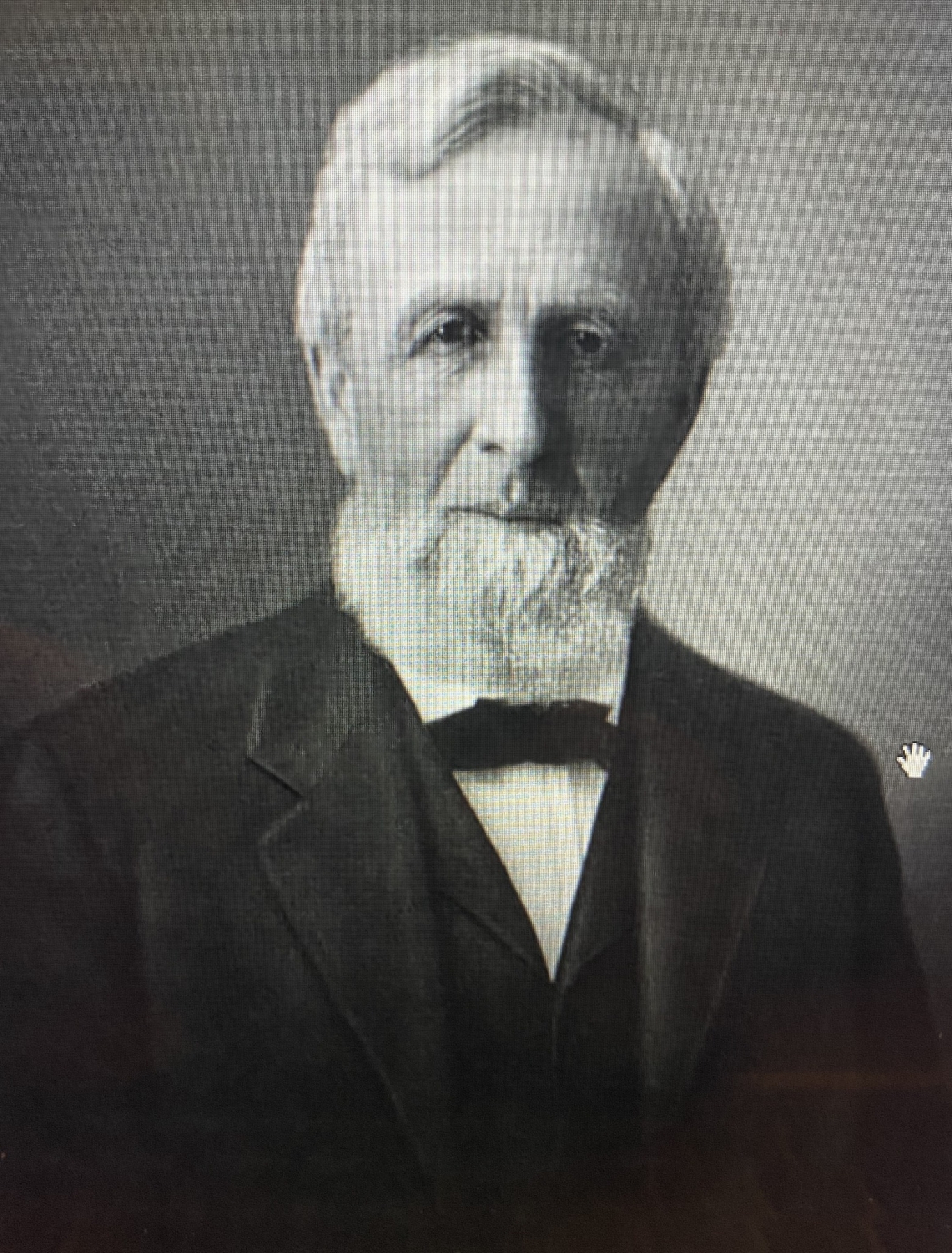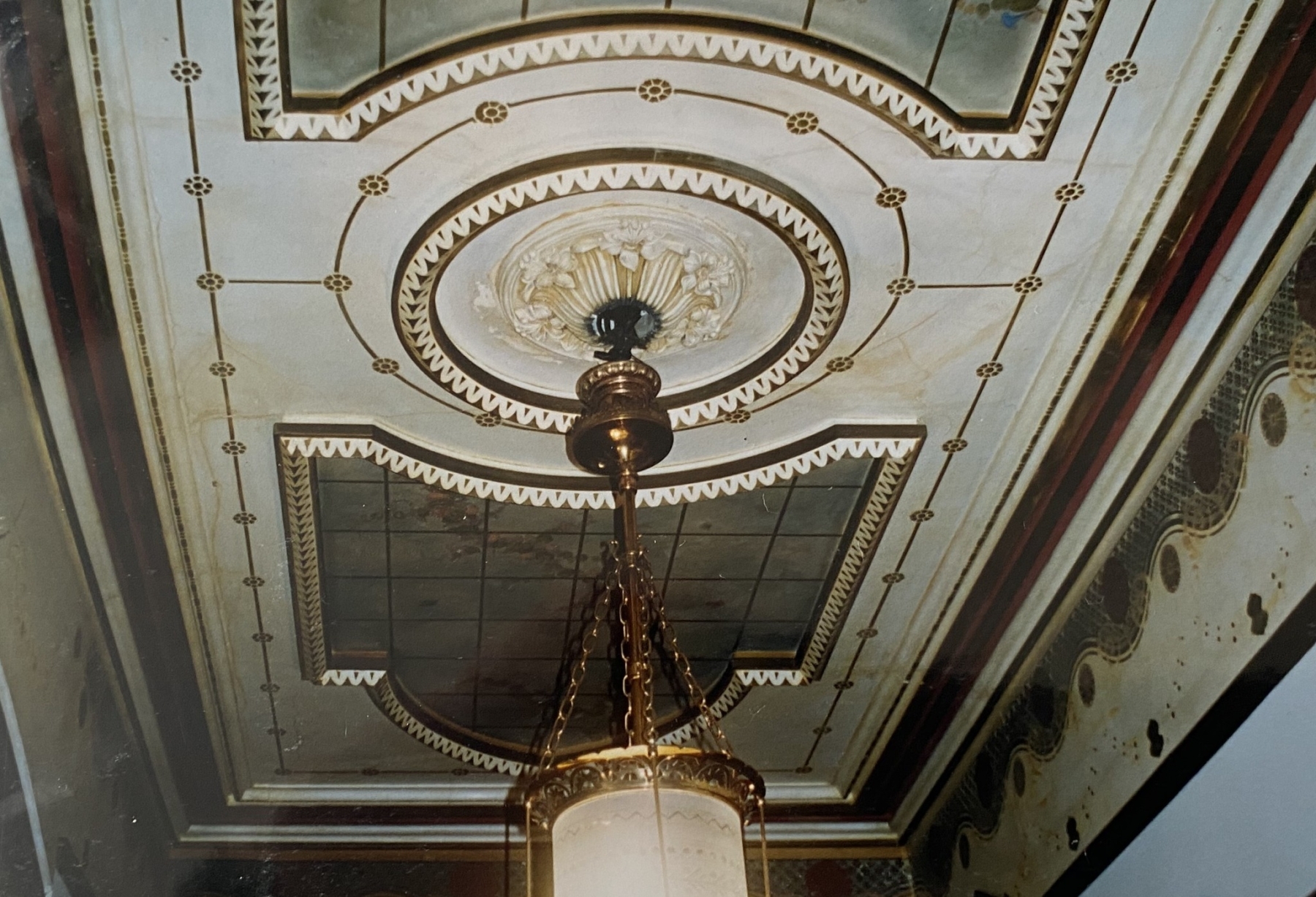“Dr Jekyll and Mr. Hyde” is playing tonight at the Cronkhite Opera House.
January 28, 1889, Cooney Archives

Cronkhite Opera House c. 1910
THE BANK OF BURKE & HELY
The Cronkhite Opera House was built on the southwest corner of Ann and Main Street, on a lot that was purchased from Charles A. Girvan, Esq. by Charles G. Burke, Esq. & Francis F. Hely, on May 1, 1872, for the sum of $10,000.
This lot was known as the old Alexander Block, inherited by Girvan’s half-brother, Henry Porteous Alexander. The Alexander’s were land agents for the Ellice Estate after the death of John Porteous, with the Ellice’s being the original owners of the land that encompassed most of Little Falls, after it was resettled after the American Revolution. Girvan purchased the lot on January 30, 1867, for $200.
Burke and Hely operated a private banking business that they had established in October of 1868, being the second bank in Little Falls, under the name of the Merchant & Farmers Bank.
According to “The Utica Daily Observer… On October 25, 1871, Charles G. Burke, formerly of this city, but now of the Merchants and Farmers Bank, Little Falls, has recently invented, and patented, which the bank is now using, a most effectual, and withal a very convenient method, to prevent the “raising” of drafts, i.e., the change of the amount for which the draft is drawn from a small to a large sum. Small coupons are engraved upon the draft, by the cutting off a portion of which the amount for which it was originally drawn is seen at a glance. In no way can the original amount of the draft be increased.”
In 1872, the banking business of Burke & Hely was first located in a rented room within the Skinner Opera House Block, which was located on the corner of Main and Mary Street, lastly known as Lurie’s, now the present-day location of CVS.
Burke & Hely’s new bank building was built at the cost of $100,000. The massive, stone and brick building, which consumed the whole corner lot, fronted along the south side of Main Street for seventy-one feet and ran eighty-four feet down along the west side of Ann Street. Erastus H. Smith excavated the lot, with the removal of two c.1800 stone buildings, finding many artifacts while doing so, such as a cannonball, a powder horn, a military saddle, and military buttons.
The architect for the project was William Metcalf of Renaissance, Utica, NY. The builders for the new structure were Thomas Dale & Sons of Little Falls, who were met with a few struggles during the construction of the opera house. The bricks used to build the building were brought in by boat up the canal, with one of the brick laden barges sinking east of here, delaying the construction work for a time. Another construction delay was because the bricklayers went on strike in 1873, demanding $5 per day for their work, up from $4.50 per day. The building was completed in 1874.
A list of individuals and companies that worked on the building were as follows: William Metcalf’s son, William J. Metcalf, who had a contract for all the carpenter work; the slate roofing was done by Jones of Utica, NY; J.Q. Smith of Syracuse did the galvanizing; the plastering was done by Jones Howarth of Utica, NY; the plumbing and gas fitting by Edward Martin of Utica, NY; the frescoing was done by Battani & Rucses of Buffalo; the painting was done by J. Perrins & Sons of Little Falls; the cutting of stone by Peter Pitkin of Rochester, NY; the cast iron work by Reddy’s Foundry of Little Falls; the ornamental columns & pilasters by Architectural of NY; and the flagging and steps by S. Sherman of Little Falls.
In 1874, The Merchants & Farmers Bank was moved to its new location within the Burke & Hely’ bank building, consuming the whole first floor. The bank had a corner entry with solid walnut doors, flanked by stone columns. There were eight offices on the second story, which were rented by lawyers, doctors, and insurance agents. The third and fourth floors were occupied by the opera house that seated up to 1,000 people. The attic housed two water tanks for the building’s use. The Town Clock that hung on the front of the building was gifted by Charles A. Girvan, Esq. Girvan also gifted to the City of Little Falls in 1905, the Girvan Square Park, which is the present-day baseball diamond. (Veterans Memorial Park)
According to “This Day In History On November 5, 1874, the Cronkhite Opera House opened with a concert.”
According to “This Day In History…On October 1, 1875, the Merchants and Farmers Bank was doing business at the Banking House on Main Street in Little Falls. Banking hours included Saturday evenings from 6:30 to 8:00 P.M.”
A BANKRUPTCY AT THE MERCHANTS & FARMERS BANK
On November 15, 1875, J.J. Gilbert sent a check for the amount of $471.62 to the Merchant & Farmers Bank, requesting that the check be dispersed in cash. The bankers, Burke & Hely, deposited Gilbert’s check instead and used the funds within their bank. Apparently, the bank had been struggling with a serious cash flow problem. The authorities were called, and Burke & Hely’s arrest was set by Judge Van Alstyne.

Merchants & Farmers Bank Check | c. 1910
According to “The Buffalo Commercial Newspaper…On December 10, 1875, the bank of Burke & Hely declared bankruptcy. Their liabilities were in the amount of $190,000., their assets can’t be readily estimated, as all the property is mortgaged. It is thought by those posted in the matter that there will be scarcely anything for the depositors. An aged lady who had deposited all her worldly treasurers to the amount of $2,000. presented herself at the doors, but as she received no satisfaction, she sank upon the steps and commenced wailing in tones that could be heard blocks away. This is only one case out of many who are really suffering from their loss.”
A warrant of bankruptcy was placed on the estates of Charles G. Burke and Richard F. Hely on January 25,1976, with the banking firm being represented by James W. Cronkhite, Esq. The list of depositors numbered five hundred and fifty depositors, with individual accounts ranging from a few dollars up to $3,227.15., which came to an overall total of deposits of $98,007.
THE BURKE & HELY BANKING HOUSE GETS A NEW NAME
Over the course of the following year, Burke & Hely’s personal properties were put up for sale through sheriff auctions, which were held at the Girvan House, being the present-day site of the Snyder Apartments. On May 2, 1877, Captain Albert Story bought Charles A. Burke’s home at 556 East Ganesvoort Street for $5,100. The lawyer for the Merchant & Farmers Bank, James William Cronkhite, Esq., bought the Burke & Hely banking house on November 17, 1878, for $28,000., with the banking house becoming known as the Cronkhite Opera House.
CHARLES GOODWIN BURKE, ESQ.
Ulie Burke, a physician, immigrated from Mayo County, Ireland in 1850, along with his wife and seven children. Charles was fourteen years old age, when the family settled in Utica, NY. He became a member of St John’s Catholic Church congregation, where he used his musical talents as an organist. Ten years later, he patented his first invention, which was a “Swell Valve”, that was a valuable improvement of the sound that a melodeon (a reed organ) instrument could produce.
He schooled as a lawyer and in 1860, he received a banking position at the Savings Bank of Utica. Burke married Frances Jane Hely, sister to Richard F. Hely, on November 4, 1864. They came to Little Falls in 1869 and over the next few years, became parents to six children.
In 1869, Burke established the banking institution, the Merchants & Farmers Bank at Little Falls, with his brother-in-law Richard F. Hely, as his partner.
According to “The Madison Observer…On March 14, 1877. A BANKER’S MISFORTUNES. —The ups and downs of life are seldom more strikingly illustrated than in the case of Mr. Charles G. Burke, formerly of Little Falls. Less than eighteen months ago he was to all appearances a thriving banker. His banking house at Little Falls was one of the finest in the State, and in his residence, he was surrounded with the comforts and luxuries of life. His wife was a beautiful and highly educated lady, and his children were the talk of all who saw them for their bright intelligence and pretty manners. A little more than a year ago Burke failed disastrously, and now the beautiful building which he erected stands comparatively tenantless. His wife and one of his children are dead. His household goods lie in the Buffalo freight house for nonpayment of charges for transportation, and he is occupying a subordinate position in the New York custom house, on a salary hardly sufficient to maintain himself and his remaining children.”
By 1889, Burke was employed in the electrical engineering field . He was living in Brooklyn with an elderly aunt, his children, and two sisters of his diseased wife.
He had four more inventions patented: in 1882 for a “main line sounder’ for the telegraphic sound instrument; in 1896 for telegraphic relay; in 1897 for systems for telegraphy: and 1903 for a telephonic apparatus.
Charles Goodwin Burke died on January 18, 1916, in Washington, DC.
RICHARD FRANCIS HELY
Hely, a first-generation Irishmen who was originally from Buffalo, NY, held a bookkeeper’s position in Utica, NY, prior to arriving in Little Falls as a partner to Charles G. Burke in the Merchant & Farmers Bank in 1868. Hely took a world tour from California to China, and then on to Europe, where he spent most of 1871. Hely married Blanche Kissam, whose family was the Astor’s and Rockefeller’s from NYC, on April 30, 1872, in the Notre Dame De Bon Secours Church in New Orleans. After the bankruptcy, he relocated back to Buffalo, where he was employed as a bookkeeper.
JAMES WILLIAM CRONKHITE, ESQ.
Cronkhite came from a wealthy farming family from Fordsbush, NY. In 1833, at the age of eighteen, he was employed as a clerk at a dry goods shop in Canajoharie. After spending three years there, he moved to Albany and with a partner opened a dry goods shop. In 1841, the Albany dry goods shop was destroyed by fire and Cronkhite returned to Fordsbush.
James then partnered with Abram Zoller in a dry goods shop in Minden. He left Minden in 1847, spending the next five years in a traveling patent medicine business. In 1852, he returned to Fordsbush and partnered with Zoller at a shop in Little Falls, which was a combination of a drugstore / bookstore, located in the present-day location of Ruggiero’s Trattoria on Main Street. Also in 1852, James married Elizabeth S. Peake on the 22nd of January.
In 1856, Cronkhite moved to Fort Plain, partnering with R.H. Shearer in the dry goods trade. While in Fort Plain, he served as a trustee on the board of the Clinton Liberal Institute, president of the First National Bank of St. Johnsville and served as the president of the Village of Fort Plain.
In 1864, James retired and moved the family to Little Falls, with purchasing the northwest corner lots of William and John Street, from William B. Houghton for $4,400. to build their new home, being 590 John Street.
James was soon back at business, taking a chance in the cheese trade as a broker. According to “This Day In History… In January of 1871, soon after the organization of the society of the Dairy Board Of Trade, the citizens of Little Falls with commendable liberality contributed several hundred dollars for the erection and fitting up of a board of trade room at the Evan’s Hotel, and it was completed in good style under the supervision of J. W. Cronkhite, of Little Falls.”
In 1878, he retired from the cheese business to manage the Cronkhite Opera House. James William Cronkhite died at his home on February 14, 1880, being sixty-five years of age.
THE CRONKHITE OPERA HOUSE GETS A NEW BANK
The Little Falls National Bank was organized in December of 1878, with the bank open for business in January of 1879, in the Cronkhite Opera House. The first bank president was Seth Richmond, the first cashier was Eleazer Rice, and the first teller was Amos Bradley.
According to “This Day In History… On June 14, 1881, a grand concert given at the Cronkhite Opera House was undoubtedly the musical event of the season. Appearing were Mr. E. A. Stoddard, baritone of New York City, Miss Nellie Bianyelt, mezzo soprano of Brooklyn, Miss Blanche Houghton, Miss Adeline H. Green, and Miss Annie Snell.”
According to “This Day In History …On November 4, 1893,
Jack Dempsey, perhaps the most popular American prize fighter, arrived in Little Falls this afternoon, and will stay at the Girvan House. He will appear in “Bottom of the Sea” at the Cronkhite Opera House tonight.”
According to “This Day In History …In July, 1895, local residents collected a thousand dollars and the Regents Department contributed five hundred dollars for establishing a public library. This was located in the Cronkhite block and when the present high school (Benton Hall Academy) was built in December of 1895, it was relocated in the basement.” In 1912, the library was transferred to the present-day Bramer-Smith House, becoming the Little Falls Public Library.
According to “This Day In History… On May 11, 1915, the annual dance of the Junior Class of Benton Hall High School was held in Cronkhite hall. The hall was finely decorated, and the music was all that could be desired, making the affair an enjoyable success in every way.”
THE DEMISE OF THE CRONKHITE OPERA HOUSE

The Little Falls National Bank’s safe being transported to the old stone bank on Ann Street after the fire of 1918.
According to “This Day In History…On November 11, 1918, the Cronkhite Opera House on the corner of South Ann and West Main streets burned. On this first Armistice Day, the bank business was moved to the old stone Herkimer County Bank building on South Ann Street, guarded by the local Home Guard Regiment. The present-day building was then built and opened on June 19, 1921.” The building was last occupied by the former Berkshire Bank.
*From The Cooney Archive’s: This Day In History by Louis Baum JR. Digitizing of historical photos by Gail & Mike Potter. Article written by Darlene Smith.
SOURCES:
Book: History of Herkimer County, New York by George Anson Hardin | Pg 127
http://www.perseus.tufts.edu/hopper/text…
http://montgomery.nygenweb.net/obits20.html
http://www.threerivershms.com/lf5.htm
https://en.wikipedia.org/wiki/Henry_P._Alexande
https://museum.dmna.ny.gov/…/121st-infantry-regiment
http://www.newhorizonsgenealogicalservices.com/ny-genealogy/…herkimerhtm
http://www.civilwardata.com/active/hdsquery.dll?RegimentHistory?1382&U
https://montgomery.nygenweb.net/gift/littlefalls.html
https://herkimer.nygenweb.net/littlefalls/sphinx1915.html
http://www.threerivershms.com/lf6.htm
Ancestry.com
Fultonhistory.com – Historic Newspapers














